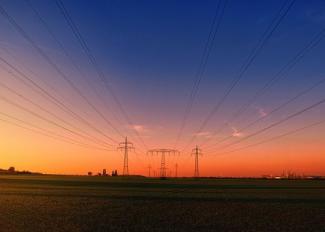In collaboration with the Office of Fossil Energy, NETL will manage the implementation of a new U.S. Department of Energy (DOE) program to accelerate the development and integration of energy storage technologies to ensure reliable supplies of affordable, clean energy from the nation’s fossil energy assets (both coal and natural gas).
“We are excited and well-positioned to serve in this critical role on behalf of DOE,” said Brian J. Anderson, Ph.D., director of NETL. “The technologies to be developed and matured through this program are essential components to build a resilient and secure electricity network to serve the nation’s energy needs.”
As the lead research and development office for DOE’s Office of Fossil Energy (FE), NETL will assist FE with developing a comprehensive strategy to expand FE’s current portfolio to include an FE Energy Storage Technology Research Program. Updates will be posted on the NETL Energy Storage for Fossil Fuel Energy Systems website.
The new program promotes energy storage in three categories. Those categories and their benefits are:
More Reliable and Affordable Energy Supply
- Reliability in a changing grid. Storage technology enables seamless transition to accommodate continued growth of intermittent renewable power and expanded use of electrified transportation.
- More secure supply. Storing power increases the ability to keep the grid running in times of cybersecurity attacks and regional environmental disaster recovery.
- Reduced customer cost. Storage technology leverages the value of energy supply investments for energy providers.
Stronger Energy Infrastructure
- More flexible electricity grid. Storage technology quickly accommodates unexpected plant shutdowns and turndowns, easing transitions between intermittent power and baseload systems.
- Improved asset management. Reduced turndowns and cycling increase equipment lifetime and help to avoid premature local and regional socioeconomic disruptions.
- Efficiently satisfy new markets. Stored energy can be made available to affordably satisfy energy demands for new ancillary services (for example, ramping, load following and black starts or the capability for power stations to restart after a failure).
Cleaner Environment
- Electricity for a greener future. Energy storage programs enable utilities to reduce the environmental footprint of baseload power plants by lowering carbon emissions and decreasing new site development demands.
A Grand Challenge
U.S. Energy Secretary Dan Brouillette announced the launch of the Energy Storage Grand Challenge in January to position the nation for global leadership in energy storage technologies by 2030. (Click here to read the DOE news release.)
As a first step in the Challenge, DOE will release a request for information soliciting stakeholder feedback on key questions and issues to address.
Over the coming weeks, a series of workshops will be held with key stakeholders to share information about various storage technologies, learn more about current barriers to deployment and help shape the work that will bring those technologies to market. Keep an eye on DOE’s Energy Storage Grand Challenge website and the Federal Register for workshop announcements. The work also will solidify the development of a coordinated R&D roadmap to 2030 for a broad suite of storage technologies.
Beyond Batteries
The new FE program will focus on a range of technologies, not just batteries. In response to a recent Request For Information, stakeholders recommended that subsurface, thermal, mechanical and chemical means be considered for fossil energy applications, in addition to electrochemical technologies like Li-Ion and flow batteries. These technologies may be particularly suited to integration with fossil fuel assets.
As an example, FE/NETL supports an Electric Power Research Institute (EPRI) project to design, construct and test a pilot-scale concrete thermal energy storage system (CTES) to demonstrate the energy storage potential of the technology when applied to coal-fired power units.
As designed, high-pressure steam from a power plant will flow through tubes, heating concrete modules. Those modules will store the thermal energy until it is returned to the power plant to generate electricity in response to grid demand. The pilot project will test modules similar in size to those expected to be used in larger-scale commercial applications.
A team at Lehigh University in Bethlehem, Pennsylvania, is also developing a prototype that uses concrete for energy storage as part of another FE/NETL-supported thermal energy storage project.
The aim of these projects is to demonstrate that a CTES system can be integrated with a coal power plant to enable low-cost energy storage that will eliminate the need for excessive operational flexibility. Concrete is just one technology to store energy. Others include thermochemical energy storage, which can involve the use of molten salts to store energy until it’s needed. Thermal energy storage should also be applicable for natural gas-based power generation assets.
Benefits of Co-locating Energy Storage with Power Generation
Fossil-fueled power plants are designed to generate power while operating at continuous maximum capacity and efficiency. However, with intermittent renewables like solar and wind on the energy grid, conventional fossil power plants are required to operate at minimum loads for periods of times. The deviation from maximum efficiency increases fuel consumption and emissions of carbon dioxide, a greenhouse gas. Reduced turndown of fossil energy plants also causes extreme stress and wear to steam-raising equipment.
That’s where energy storage systems can provide valuable assistance. Using such systems, a fossil fuel-based plant can continue to operate at high efficiency and store excess power until it’s needed by the grid, reducing the need to operate at fluctuating operational loads while improving the security of the nation’s power supply.
Over the next several decades, fossil energy plants will continue provide much of the nation’s energy. As the use of variable renewable energy increases, energy storage at the generation site will be an essential component to ensure a resilient electricity network. FE/NETL’s Energy Storage program will drive the technological solutions to meet that challenge.
Watch for updates about these and other technologies as NETL moves forward with the Fossil Energy Storage Research Program.




